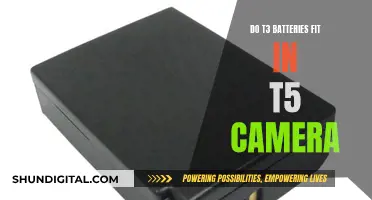
If you've ever left your camera in a drawer for a long period of time, you may have returned to find that the batteries have leaked and corroded, leaving a white, crusty residue in the battery compartment. This corrosion is caused by a build-up of gas that leaks out of the batteries in the form of battery acid. While it may seem like your camera is ruined, there are ways to clean the corrosion and salvage your device. In this guide, we will outline the steps you need to take to clean your camera's battery compartment and restore it to working order. We will also provide tips on how to prevent corrosion from occurring in the first place.
| Characteristics | Values |
|---|---|
| Protective gear | Gloves, safety goggles or eye protection, long-sleeved clothing |
| Tools | Cotton swabs, white vinegar or lemon juice, rubbing alcohol, pencil eraser, microfiber cloth, compressed gas, small screwdriver, toothbrush, foam Q-tips, high-strength isopropyl alcohol |
| Procedure | Remove batteries, wipe away corrosion debris, dip swab in vinegar or lemon juice, clean components, dry with a cotton swab, let the compartment dry before putting in new batteries |
| Prevention | Take out batteries from devices that won't be used for a while, store devices in a dry and cool place, avoid using expired batteries |
What You'll Learn

Wear gloves and eye protection to prevent burns and permanent damage
When cleaning a camera battery compartment, it is important to wear gloves and eye protection to prevent burns and permanent damage. This is because the chemicals exposed during battery leakage, such as sulfuric acid, are caustic and corrosive. They can cause serious burns to the skin and permanent damage to the eyes. By wearing gloves, you create a protective barrier between your skin and these harmful substances. Eye protection, such as safety goggles or glasses, shields your eyes from any splashes or fumes that may occur during the cleaning process.
It is also important to work in a well-ventilated area when cleaning a camera battery compartment. The fumes released by the corrosive substances can be harmful if inhaled. By ensuring there is adequate ventilation, you reduce the risk of inhaling these toxic fumes. Additionally, having a well-ventilated space helps dissipate any fumes that may be generated during the cleaning process, further reducing the risk of exposure.
Before beginning the cleaning process, make sure to remove any jewelry, especially metal rings. Jewelry can create a circuit between the positive and negative terminals of the battery, leading to a massive release of energy and severe burns. It is also recommended to cover any metal tools or handles with tape to insulate them and prevent accidental short-circuiting.
When handling the batteries, always wear gloves. Even batteries that do not appear corroded can contain harmful chemicals. Place the removed batteries in a plastic bag for proper disposal, following the waste guidelines in your community. Do not attempt to clean the batteries themselves, as this can be dangerous.
By taking these precautions and wearing the appropriate protective gear, you can effectively clean a camera battery compartment while minimizing the risk of burns and permanent damage to your health and safety.
Action Camera Batteries: Are They Interchangeable?
You may want to see also

Remove batteries and wipe away corrosion debris
Removing the batteries is the first step in cleaning a camera battery compartment. This is because the crusty, white residue that builds up is caused by battery corrosion, which occurs when batteries are left in a device for a long time and slowly discharge, leaking battery acid. This acid can be caustic, so it is important to wear gloves when handling the batteries and cleaning the compartment.
Once the batteries have been removed, the next step is to wipe away any corrosion debris. This can be done with a cotton swab or a soft-bristled brush. It is important to be gentle during this step to avoid damaging the camera's internals. The corrosion should be wiped away until the metal underneath is revealed. If the corrosion is particularly stubborn, a toothbrush can be used to scrub it away.
Some sources recommend using a vinegar and water solution to help remove the corrosion. The vinegar will react with the baking soda, creating oxygen and aiding in the removal of the corrosion. The vinegar and water solution can be applied to a cotton swab or toothbrush and gently rubbed onto the affected areas. However, it is important to be careful when using vinegar, as too much can damage the camera's internals.
After wiping away the corrosion debris, the compartment should be cleaned with isopropyl alcohol to remove any remaining residue. This can be done using a foam or cotton swab, taking care to get into all the nooks and crannies of the battery compartment. The camera should then be left to dry for several hours to ensure that any remaining liquid evaporates.
Charging Olympus Stylus Tough Camera: A Step-by-Step Guide
You may want to see also

Use vinegar or lemon juice to neutralise corrosion
If you're looking to clean your camera's battery compartment, you'll need to be careful, as the acid from the batteries can be caustic and cause irritation to your skin and eyes. It's important to protect yourself by wearing gloves and safety goggles.
Now, onto cleaning the compartment with vinegar or lemon juice. First, remove the batteries from your camera. Then, dip a cotton swab into some vinegar or lemon juice. Be careful not to oversaturate the swab, as you don't want the liquid to drip into the electrical components of your camera. Gently wipe the battery compartment and contacts with the swab, neutralising the corrosion. You may hear a slight sizzle, which is a good sign.
Once you've wiped down the compartment, dry the contacts with a clean paper towel. If there's any stubborn residue remaining, use a small flathead screwdriver or a similar tool to gently scrape it off.
Finally, apply a light coating of silicone grease or petroleum jelly to the contacts. This will prevent future corrosion and improve the connection between the contact and the battery. Put in fresh batteries, close the compartment, and turn on your camera to make sure it's working.
Y Dome Camera: Battery-Powered Security Solution?
You may want to see also

Apply isopropyl alcohol to remove residue
When cleaning a camera battery compartment, isopropyl alcohol is a safe and effective way to remove residue without leaving behind moisture. It is also useful for removing residue from other cleaning agents, such as lemon juice or white vinegar, which are often used to neutralise the acid in battery corrosion.
To apply isopropyl alcohol to your camera battery compartment, you should first ensure you are using the purest form of isopropyl alcohol you can find. Check the label on your bottle, as the wipes that come with first-aid kits often contain only 70% isopropyl alcohol, which will work for external plastic or metal, but for internal electronics, 90% to 99% is preferable.
Once you have your isopropyl alcohol, you can apply it to the affected area using a cotton swab or foam Q-tip. You can also use a toothbrush for larger, more corroded areas, like the battery compartment cover. Dip your chosen applicator into the isopropyl alcohol and wipe or scrub the affected area until the residue is removed.
After you have finished cleaning, it is important to let the camera battery compartment air dry completely before replacing the batteries and turning on the device.
Why 18650 Batteries Are Popular in Cameras
You may want to see also

Leave the compartment to dry before replacing batteries
Leaving the battery compartment to dry is an essential step in the cleaning process. It is important to be patient and allow sufficient time for the compartment to dry completely before replacing the batteries. This step ensures that any residual moisture or cleaning solution is evaporated and does not cause further damage or corrosion to the battery contacts and camera circuitry.
The time required for the compartment to dry thoroughly will depend on various factors, including the cleaning agents used, the amount of moisture present, and the environmental conditions. In some cases, a few hours may be sufficient, while in others, it may take longer. It is advisable to leave the camera in a dry and well-ventilated area to expedite the drying process.
During the drying process, it is crucial to keep the camera upright to prevent any liquid from dripping into sensitive components. Placing the camera on a soft, absorbent cloth can help catch any residual moisture or drips. Additionally, a well-ventilated area will aid in evaporating any remaining liquid or vapours.
While waiting for the compartment to dry, it is essential to resist the temptation to test the camera or insert the batteries. Turning on the device before it is completely dry can lead to electrical shorts or further corrosion. It is also important to ensure that the battery compartment is free of any debris or residue before replacing the batteries.
Once the compartment is completely dry, you can proceed with installing fresh, new batteries. It is recommended to use high-quality batteries and avoid leaving them in the camera for extended periods if the device will not be in use. Regularly removing and storing batteries separately can help prevent future corrosion and ensure the longevity of your camera equipment.
Charging Cameras Off-Grid: Keep Your Camera Always Ready
You may want to see also
Frequently asked questions
First, put on protective gloves and goggles to prevent any burns from the corrosive chemicals. Next, remove the batteries and use a cotton swab to gently wipe away any debris. Then, use a swab dipped in vinegar or lemon juice to clean the compartment, followed by a dry swab to remove any moisture. Finally, leave the compartment open to dry completely before inserting new batteries.
Protective gloves and goggles are essential when cleaning a camera battery compartment. Cotton swabs are ideal for removing debris and applying vinegar or lemon juice to the affected area. You can also use a soft cloth to catch any drips or crumbs. For more corroded areas, you may need a toothbrush. To finish, use a microfiber cloth or a pencil eraser to polish the area.
When batteries are left in a device for a long time, they continue to slowly discharge, and a build-up of gas will leak out in the form of corrosive battery acid. This acid then builds up as a white, crusty residue in the battery compartment.
If there is corrosion on the battery terminals, you may need fine-grit sandpaper to clean them.
The best way to prevent corrosion is to take the batteries out of devices that you may not use for a while. Heat and moisture affect how quickly batteries corrode, so always store your camera in a dry, cool place.







